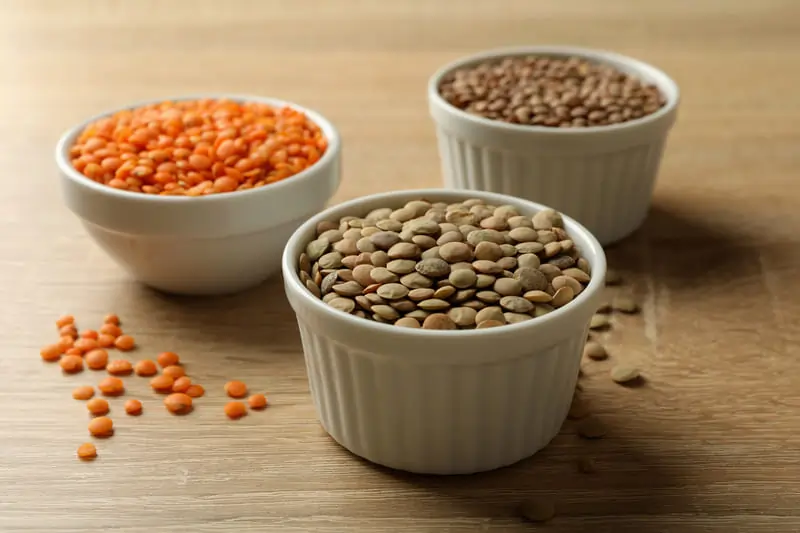Pros and Cons of Lentils have long been a staple in various cuisines across the globe, offering an affordable, fiber-rich source of plant-based protein. While often overshadowed by beans and other legumes and pulses, lentils have recently enjoyed renewed popularity as more people adopt flexitarian or vegetarian eating patterns. Their ability to blend seamlessly into soups, stews, salads, and even burger patties showcases their impressive culinary versatility.
If you’re just discovering lentils or looking for an easy way to incorporate them into your meals, check out the Hearty Lentil Soup recipe, which uses simple ingredients to create a nutrient-dense meal. For those on a budget, the Budget-Friendly Lentil Dishes post offers creative ways to utilize lentils without breaking the bank. Understanding these options will help illustrate both the pros and cons of lentils we’ll be exploring below.
Many health professionals recommend focusing on heart-healthy foods to reduce cardiovascular risk, and lentils often make the cut. Following guidelines from resources like the Mayo Clinic can guide you toward a well-rounded, high-fiber diet. Given lentils’ robust nutrient profile, it’s no wonder they frequently appear on “best foods” lists for overall wellness—even if they do come with certain drawbacks that we’ll discuss.
What Are Lentils?

Pros and Cons of Lentils
Lentils are small, disk-shaped legumes that come in several varieties: brown, green, red, yellow, and black (Beluga lentils). Each type has a slightly different flavor, texture, and cooking time, making them suitable for diverse recipes. Historically, lentils trace their roots back thousands of years to regions in the Middle East, Asia, and the Mediterranean, where they were prized for their affordability, long storage life, and nutrient density.
Definition & Brief History
- Origins: Ancient civilizations from regions like Mesopotamia and the Indus Valley used lentils for sustenance, trade, and cultural cuisine.
- Global Spread: Over centuries, lentils found their way into dishes like Indian dal, Middle Eastern stews, and European soups, highlighting their versatility.
Culinary Versatility
- In Soups & Stews: Brown lentils hold their shape, while red lentils break down easily, resulting in thicker textures.
- In Salads & Bowls: Green lentils offer a peppery taste and firm texture, making them ideal for cold salads.
- In Veggie Burgers: Mashed lentils combine with breadcrumbs and seasonings to form a protein-packed patty.
Nutritional Overview
lentil benefits and drawbacks
Lentils are a nutritional powerhouse, providing an exceptional balance of macronutrients and micronutrients. According to various research sources, lentils play a vital role in enhancing dietary patterns, making them a staple for many health-conscious individuals. Below is an in-depth exploration of their impressive nutritional profile.
Macronutrients
Protein
Lentils are lauded for their plant-based protein content, offering approximately 18 grams per cooked cup. This makes them an excellent protein source for vegetarians, vegans, and those looking to reduce their meat intake. Protein from lentils supports muscle repair, boosts metabolism, and provides sustained energy. For more ways to incorporate lentils into vegetarian meals, read Is Lentil Soup Really Good for You?.
Carbohydrates & Fiber
Lentils are rich in complex carbohydrates that provide a gradual release of glucose into the bloodstream. This characteristic helps stabilize blood sugar levels, making lentils a suitable choice for individuals managing diabetes. Additionally, lentils contain 12 to 16 grams of fiber per cup, with a balance of soluble and insoluble fiber.
- Soluble fiber aids in cholesterol reduction and promotes heart health.
- Insoluble fiber supports digestive health by improving bowel regularity.
For tips on incorporating fiber-rich lentils into your diet, explore Does Lentil Soup Burn Belly Fat?.
Fats
Naturally low in fat, lentils align well with dietary goals like heart health and weight management. Any added fats in lentil dishes usually come from ingredients like olive oil or coconut milk. Using healthy fats sparingly can enhance flavor without detracting from lentils’ low-fat benefits. For insights into choosing the right fats, visit Do I Need to Rinse Lentils Before Making Soup?.
Micronutrients
Vitamins
Lentils are a rich source of folate and other B vitamins that are critical for cellular function, energy production, and metabolism. Folate is particularly essential for pregnant women and those looking to improve brain health. By including additional ingredients like carrots or tomatoes in lentil soup, you can further elevate levels of vitamin A, which is important for vision and immune health.
Minerals
Lentils are abundant in minerals that contribute to overall well-being:
- Iron: Supports oxygen transport and helps prevent anemia.
- Magnesium: Aids in muscle function and relaxation, making lentils a great choice for those with active lifestyles.
- Potassium: Helps regulate blood pressure and improves cardiovascular health.
- Zinc: Plays a key role in strengthening immune response and healing wounds.
To discover how lentils integrate into a heart-friendly lifestyle, check out Sausage and Lentil Soup: A Hearty Classic.
Calorie Profile
A single cup of cooked lentils contains between 200 and 230 calories. This nutrient-dense profile makes lentils an excellent choice for meals that are both filling and nutritious. Compared to animal proteins with similar calorie counts, lentils provide higher fiber and carbohydrate content, supporting longer-lasting energy and better digestive health. For a detailed comparison of lentil soup and its nutritional advantages, see Does Lentil Soup Burn Belly Fat?.
Pros of Lentils
Lentils have gained widespread popularity among health-conscious individuals for their remarkable nutritional benefits and versatility. They provide a simple yet effective way to enhance overall health while aligning with sustainable and budget-friendly eating habits. Here’s a closer look at the key advantages lentils bring to the table.
Heart Health
Fiber & Cholesterol Management
Lentils are rich in soluble fiber, which plays a crucial role in reducing LDL cholesterol (often referred to as “bad cholesterol”). Lower cholesterol levels contribute to improved cardiovascular health and a reduced risk of heart disease. If you’re looking for recipes that combine heart-healthy ingredients with lentils, explore Is Lentil Soup Really Good for You?.
Blood Pressure Regulation
Packed with nutrients like potassium and magnesium, lentils help maintain healthy blood pressure levels. Potassium offsets the effects of sodium, while magnesium supports vascular health by helping blood vessels relax. Including lentils in your diet regularly can be a proactive step toward a healthier heart. For more ideas, check out Sausage and Lentil Soup: A Hearty Classic.
Weight Management
Satiety
Lentils combine protein and fiber, which work together to keep you full longer after meals. This can reduce the temptation to snack on calorie-dense foods, making lentils an excellent addition to any weight management plan. For a filling, low-calorie meal option, see Does Lentil Soup Burn Belly Fat?.
Low Glycemic Index
As a low-glycemic food, lentils provide a steady release of energy without causing sudden spikes or drops in blood sugar. This stabilization not only helps manage hunger but also supports consistent energy levels, which are crucial for maintaining an active lifestyle.
Protein Source for Plant-Based Diets

Essential Amino Acids
Lentils are a rich source of essential amino acids, coming close to offering a complete amino acid profile. Pairing lentils with grains like quinoa or brown rice can create a balanced protein source, making them an indispensable component of vegetarian and vegan diets. For tips on enhancing lentil-based meals, read Do I Need to Rinse Lentils Before Making Soup?.
Versatile Applications
Lentils shine in their adaptability across a wide variety of dishes. Whether you add them to soups, stews, or salads or use them as the base for burgers or patties, lentils allow for creative and nutritious plant-based meals. Discover more ways to enjoy lentils in Sausage and Lentil Soup: A Hearty Classic.
Cost-Effectiveness & Sustainability
Budget-Friendly
Lentils are highly economical, often costing significantly less than animal-based proteins. A small amount of dried lentils goes a long way, making them an excellent choice for meal planning on a budget. For more on affordable and nutritious recipes, explore Is Lentil Soup OK for Kidneys?.
Lower Carbon Footprint
Compared to livestock production, lentils require fewer natural resources, including water and land, and generate fewer greenhouse gas emissions. By incorporating lentils into your meals, you’re making an environmentally conscious decision while enjoying a nutrient-packed ingredient.
Digestive Health
Fiber Content
Lentils contain both soluble and insoluble fiber, which supports overall digestive health. Soluble fiber slows digestion, promoting the absorption of nutrients, while insoluble fiber adds bulk to stool, preventing constipation. Including lentils in your meals regularly can contribute to a healthier gut microbiome.
Prebiotic Effects
The fiber in lentils also serves as a prebiotic, feeding the beneficial bacteria in your gut. These healthy gut bacteria play a pivotal role in digestion, immunity, and even mental health. For recipes that emphasize digestive-friendly ingredients, visit Does Lentil Soup Burn Belly Fat?.
Cons of Lentils
While lentils are packed with nutrients and offer numerous health benefits, it’s important to be mindful of some potential drawbacks. These considerations ensure that lentils are incorporated into your diet in a way that optimizes their benefits while minimizing potential issues.
Gas and Bloating
High Fiber and Oligosaccharides
The high fiber content in lentils, which supports digestive health, can sometimes lead to discomfort for individuals not accustomed to a high-fiber diet. Lentils also contain oligosaccharides, a type of carbohydrate that ferments in the gut, potentially causing bloating or gas. For those exploring ways to reduce this discomfort, soaking lentils before cooking can be a helpful step. Learn more about preparing lentils effectively in Do I Need to Rinse Lentils Before Making Soup?.
Mitigation
- Soaking: Soaking lentils overnight helps reduce oligosaccharides and makes them easier to digest.
- Sprouting: Encouraging enzyme production through sprouting breaks down complex carbohydrates, further reducing the likelihood of digestive issues.
Anti-Nutrients
Phytates and Tannins
Lentils contain phytates and tannins, which are natural compounds that can inhibit the absorption of essential minerals like iron and zinc. This is particularly relevant for individuals who rely heavily on lentils as a dietary staple. However, the impact of these anti-nutrients can be minimized through proper preparation techniques.
Reduction Techniques
- Cooking Thoroughly: Proper cooking neutralizes a significant portion of these compounds, enhancing nutrient bioavailability.
- Soaking: Like with gas-reducing methods, soaking can help lower phytate levels.
- Pairing with Vitamin C-Rich Foods: Adding ingredients like tomatoes, bell peppers, or lemon juice improves iron absorption. For more ways to optimize lentil nutrition, explore Sausage and Lentil Soup: A Hearty Classic.
Allergies and Sensitivities
Rare Lentil Allergy
Though rare, some individuals may experience allergic reactions to lentils, such as skin rashes, respiratory discomfort, or digestive upset. This is particularly important to consider for people with known food allergies.
Cross-Reactivity
Individuals with allergies to peanuts or other legumes should exercise caution, as lentils can trigger cross-reactive allergic responses. If you suspect sensitivity to lentils, consult with a healthcare provider before making them a regular part of your diet. For alternative ingredient ideas, check out Is Lentil Soup Really Good for You?.
Overconsumption
Excess Calories
While lentils themselves are nutrient-dense and relatively low in calories, adding high-fat ingredients like cream, butter, or excessive oil can quickly raise the calorie content of lentil dishes. Opting for healthier additions, such as olive oil or avocado, ensures a balanced approach. For more tips on keeping lentil-based meals light, visit Does Lentil Soup Burn Belly Fat?.
Dietary Imbalance
Relying solely on lentils for protein without incorporating other nutrient sources can lead to nutritional gaps. For example, while lentils are high in protein, they lack vitamin B12, which is only found in animal products or fortified foods. To avoid imbalance, complement lentils with a variety of whole grains, vegetables, and fortified foods.
How to Incorporate Lentils in Your Diet (Part 2)
Adding lentils to your diet is both easy and rewarding, thanks to their versatility and nutrient-rich profile. Whether you’re crafting a comforting soup or experimenting with creative plant-based dishes, lentils adapt well to a variety of cooking methods and recipes. Below are practical tips and ideas to make lentils a staple in your meal plan.
Cooking Methods
Stovetop
Cooking lentils on the stovetop is a straightforward and reliable method. Begin by rinsing the lentils thoroughly to remove debris and reduce any naturally occurring compounds that might affect digestion. Soaking lentils beforehand is optional but can help reduce cooking time and improve digestibility.
- Brown or Green Lentils: Simmer for about 20–30 minutes until tender but firm enough to hold their shape. These varieties are perfect for soups and salads.
- Red or Yellow Lentils: These softer varieties cook faster, typically in 10–15 minutes, and are ideal for pureed soups or curries. For preparation tips tailored to lentil-based soups, see Do I Need to Rinse Lentils Before Making Soup?.
Instant Pot and Slow Cooker
For those with busy schedules, using an Instant Pot or slow cooker is a game-changer.
- The Instant Pot can cook lentils in just 6–10 minutes under pressure, making it a convenient choice for quick dinners.
- Slow cookers allow lentils to simmer on low heat for 6–8 hours, which enhances flavor and retains moisture, creating a creamier texture perfect for stews and chilies. For ideas on hearty lentil recipes, visit Sausage and Lentil Soup: A Hearty Classic.
Sprouting
Sprouting lentils unlocks additional nutrients and offers a fresh, crunchy texture for lighter dishes.
- Soak lentils overnight in water.
- Rinse and drain them thoroughly.
- Leave them in a jar or container, rinsing daily, until small sprouts appear in 2–3 days.
Sprouted lentils are an excellent addition to salads or stir-fries. For more on their digestive benefits, check out Does Lentil Soup Burn Belly Fat?.
Recipe Ideas
Soups and Stews
Lentils form the backbone of many comforting dishes, thanks to their earthy flavor and protein content.
- Prepare a classic hearty lentil soup with carrots, celery, and tomatoes for a nutritious one-pot meal.
- Experiment with spicy dal by cooking red lentils with turmeric, ginger, and chilies for an Indian-inspired dish.
- Add lentils to chili for a plant-based twist packed with flavor and nutrients. For more soup inspirations, explore Is Lentil Soup Really Good for You?.
Salads and Bowls
Green lentils are perfect for salads due to their firm texture and nutty taste.
- Toss cooked lentils with fresh vegetables, olive oil, and lemon juice for a refreshing side dish.
- Create a protein-packed grain bowl by layering lentils, quinoa, roasted vegetables, and tahini dressing.
Veggie Burgers
Transform cooked lentils into satisfying plant-based patties.
- Mash cooked lentils with breadcrumbs, onions, garlic, and spices like cumin or smoked paprika.
- Shape into patties and pan-fry until golden brown.
These burgers pair wonderfully with whole-grain buns and your favorite toppings. For tips on balancing plant-based meals, see Is Lentil Soup OK for Kidneys?.
FAQs Of Pros and Cons of Lentils
- Are lentils good or bad for you?
Lentils are generally good for you, offering fiber, protein, and vitamins. Their downsides (gas, anti-nutrients) can be managed via proper cooking. Check out Are Lentils Healthy? for more details on balancing lentils in your diet. - Which color lentil is healthiest?
Each lentil color has a slightly different nutrient profile and flavor. Green and brown lentils hold their shape, while red and yellow cook faster. For a breakdown of different types, see Colorful Lentil Guide. - Do lentils cause inflammation?
Lentils are typically considered anti-inflammatory. Proper cooking reduces any lectin-related concerns. If you’d like more information, check out Anti-Inflammatory Lentil Recipes. - Are lentils hard to digest?
They can be for those unaccustomed to high-fiber foods. Soaking, sprouting, and cooking thoroughly helps ease digestion. Learn more in Soaking and Sprouting Lentils 101. - Can lentils replace meat in a diet?
Lentils offer solid plant-based protein but lack some micronutrients found in meat (e.g., vitamin B12). Pairing them with fortified foods or supplements can fill the gap. Read more about this in Meatless Mondays with Lentils. - Do lentils cause weight gain?
Not usually. Lentils have fewer calories compared to many animal proteins. Weight gain concerns arise mostly from high-fat additions or overly large portions. Explore Healthy Lentil Meals for Weight Management to see how they can fit into a balanced diet.
Conclusion About Pros and Cons of Lentils
From heart health and weight management to sustainability and cost-effectiveness, lentils offer a wide range of benefits. Yet, they also come with challenges like gas, anti-nutrients, and potential allergies. By prepping lentils thoughtfully—soaking, sprouting, and cooking adequately—you can mitigate most negatives while reaping their significant nutritional rewards.

